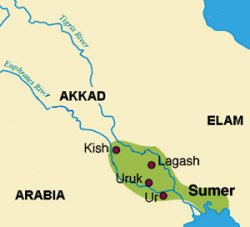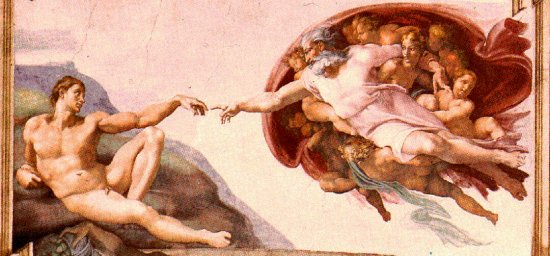
Sumer (or Sumeria or Shin'Ar) was an
ancient civilization and historical region situated in the
southernmost part of Mesopotamia between the Tigris and the Euphrates
rivers, in the area that later became Babylonia and is now southern
Iraq from around Baghdad to the Persian Gulf. It the earliest known
civilization in the world.

The Sumerians called their land:
"ki-en-gir", which could be translated to: "land of
the civilized lords", or "native land". According to
modern archaeology, it rose estimated between 4,500 and 4,001 BC,
and it's ultimate decline was around 1,700 BC with the rise of
Babylonia under Hammurabi.
The original discovery of Sumerian civilization between the Tigris and Euphrates, by archaeologists in the 1870s, was due to the consideration of biblical scriptures about Shinar (a possible variant of the name "Shumer"). Shin"Ar or Sumer translates to "Land of the Watchers". (In the sense of "those who observe".)
The Sumerians had a flourishing culture and wrote all kinds of things like we would do today on clay tablets in cuneiform script, including: rules, laws, poetry, and stories (myths). These are currently the earliest recognized forms of writing. It is characterized by a composition of wedge-shaped formations and was used by the Sumerians, Akkadians (Assyrians/Babylonians) and Persians. In the 1760s, Karsten Biebuhr brought back bricks with cuneiform from a dig in Egypt, Arabia, and Syria. In 1802, Georg Friedrich Grotefend, a German school teacher, was the first to decipher the Sumerian writings thanks to the Behistun-inscription that was in multiple cuneiform languages: Old Persian, Elamite and Old Babylonian. (In a similar way as with the Rosetta stone.)
The Old Testament from the Bible originated from the Tanakh of Judaism and the first five books: Genesis, Exodus, Leviticus, Numeri and Deuteronomium, are known as the Torah. Certain Sumerian and Babylonian myths are quite similar to those ancient scriptures including the Tanakh and thus also the Old Testament of Christianity, but the Sumerian myths are known to be much older. This implies that these Biblical stories of Genesis probably originated from earlier Sumerian and Babylonian myths.
Abraham, the first patriarch of the people of Israel, was born in the Sumerian city of Ur, from where he later migrated with his family to Canaan (which is now roughly corresponding to modern-day Israel, Palestine, Lebanon, and the western parts of Jordan and Syria.) Abraham probably grew up with these Sumerian myths, and that would explain the similarities. For many generations and hundreds of years, the descendants of Abraham had been retold their stories until they were finally written down in the Torah; the first five books of the Tanakh. This was probably done by Moses; the founder of the Israelite religion, as he could write because of his education at the Egyptian court.
From: "Myths of Enki, the Crafty God", by Samuel Noah Kramer (world renowned Assyriologist and one of the foremost authorities on the ancient Sumerian language and literature) and John R. Maier:
"Sumerian literature contained a number of literary forms and themes found much later in the Bible... there are many parallels to Sumerian literature in biblical themes." (Page 154)
For example, the story of Noah's ark from the Book of Genesis, is quite similar to the Akkadian Epic of Atrahasis, and part of the story about Utnapistim in the Babylonian Epic of Gilgamesh (which is essentially the same story from the Epic of Atrahasis with some minor differences).
Even the texts side by side are similar:
"The gods smelled
the savor"
(Atrahasis III,v,34)
"The gods smelled the sweet
savor" (Gilgamesh XI, 160)
"And the Lord smelled
the sweet savor..." (Genesis 8:21)
There also was another flood myth called: the tale of Ziusudra, who was the ruler of Shuruppak, which was written in Sumerian. The single fragmentary tablet containing the story was dated to the 17th century BC (Old Babylonian Empire), which makes it older than the Epic of Gilgamesh which was dated to c. 1,100 BC.
A remarkable difference between the modern Mesopotamian myths and
the Bible, is that in the Mesopotamian myths there is the mention of
the word "gods" in place of the "LORD". This is
because the word "Elohim", from the original ancient Hebrew
texts, had not been translated accurately enough. In the modern Bible
the ancient Hebrew word "Elohim" had been translated as the
"LORD", and in more recent versions and revisions, it was
even translated as "God". According to the original Jewish
teachings, the word "Elohim" is plural and literally
translates to "Godly beings".
Furthermore, God is also 425 times referred to as "Adonai" in the
Bible, which is also in plural form that literary means "Lords". (The
plural form of the word "Adon", which means "Lord".)
Genesis 1:26 even clearly speaks in plural:
"God (Elohim) said: Let us make man in our own image."

"The
Creation of Adam", by Michaelangelo Buonarroti
(On the ceiling of the Sistine Chapel)
This message also echoes throughout Greek mythology, where it is stated that man was created in the image of the "gods", and the section of the early Sumerian epic of creation: the "Enûma Eliš", in which the "gods" did create mankind (ch. 6:4).
In his work: "Yad ha-Chazakah: Yesodei ha-Torah", the medieval philospher Moses Maimonides (1135-1204) counts ten ranks of angels in the Jewish angelic hierarchy. Here the "Elohim" - translated as: "Godly beings" - are ranked at nr.7, below the "Malakhim" (messengers, angels) and above "Bene Elohim": "Sons of Godly beings" (the "sons of God" who were mentioned in the Old Testament from the Bible). The hierarchy is described as following:
Chayot Ha Kodesh ("Holy Living Ones")
Ophanim ("Wheels")
Erelim ("Thrones / Brave Ones")
Hashmallim ("Electric Ones / Glowing Ones / Amber Ones")
Seraphim ("Burning Ones")
Malakhim ("Messengers")
Elohim ("Godly Beings")
Bene Elohim ("Sons of Godly Beings / "Sons of God" in the Bible)
Cheribim ("Strong Ones")
Ishim ("Men / Man-like beings, persons")
According to a lecture of Austrian philosopher, writer,
architect, social reformer and esotericist Rudolf Joseph Lorenz
Steiner (1861-1925), there would exist higher beings without a
physical body who are connected with the evolution of mankind. From
his lecture: "Egyptian
Myths and Mysteries, Lecture 5":
"...in the fullness of the light there should also live all those other high beings who, although not assuming a physical body, were connected with the evolution of man: Angels, Archangels and Principalities. But not only were these present. In the fullness of the light lived still higher beings also: the Powers, or Exusiai, or Spirits of Form; the Virtues, or Dynameis, or Spirits of Motion; the Dominions, or Kyriotetes, or Spirits of Wisdom; those spirits who are called the Thrones, or Spirits of Will; finally, in looser connection with the fullness of the light, more and more detaching themselves therefrom, the Cherubim and Seraphim. The earth was a world inhabited by a whole hierarchy of lower and higher beings, all sublime."
Eloah (or Eloha) is the singular form of the plural word "Elohim", and would translate to "God", or "Godly being". It had been used in the Tanakh and the Bible, especially in the more poetic chapters; At six places it is used to describe "pagan" gods (like in Chronicles 32:15 and Daniel 11:37-8), though in the most cases it is used to refer to the "God of Israel", known in the Tanakh as Yahweh (YHWH) and Jehova (JHVH) in the English and Greek Bible. Eloah also doesn't specifically refers to a male being because this word is both male and female in the language of Old Hebrew.
According to numerous esoteric sources and channeled messages from
psychic intuitives; In the beginning there only was the Oneness that
was later given many names including: God, the All,
the Father, the Source, the Creator, and the Great Spirit. (George
Lucas called it: the "Force" in his
movie Star Wars (1977), but unfortunately it seems that to this day
it is rarely understood as a concept for a transcendent God that is
within everything.) Because of the desire of companionship and to
create, explore and experience the Self, the Oneness took the form of
a large multitude of "souls". As the "sons"
or "children" of God now had the possibility to act
independent from each other, one had free will to make their own
choices. Seemingly divided we are still energetically connected with
each other on a higher, unseen level.
Figuratively spoken - like the cells in a body - one is in a
certain way on its own but also connected together as a one whole or
"(w)holy" Spirit. (The word: "holy" had been
derived from the word "whole": "(w)holy" or to be
whole.) When seen from the most high perspective, any form of
separation is nothing more than an illusion as we are all connected,
as every soul is connected with each other on an energetic level -
even as though most people are not aware of this. That is why it is
good to feel affection and appreciation for and from each other. In
addition, this connection creates a field of knowledge, wisdom and
other information, and is also the source where intuitive information
comes from including: strong forebodings, déjà-vu's, prophetic dreams
and the insights of psychic intuitives. Everything that exists in
our universe is the embodiment of God and everything that has
consciousness forms the so-called "super consciousness", where one
however is usually not aware of during a normal waking state of
consciousness.
The Biblical patriarchs had the ability to make contact with this super
consciousness that we call God in order to receive instructions,
knowledge and insight to lead their people.
One part of these children of God wished to experience Its own Creation by exploring the Universe in bodies of their own, which came at the expense of a drop in consciousness and knowledge of its Divine origin whereby the "ego", or the personality, was formed by which one could experience the illusion of separation; like *if* they were really separated from each other and the rest of the Cosmos. Other souls that we know as the Arch-angels usually never departed and remained loyal to the Source and therefore they kept the most elevated and unadulterated form of consciousness. (Explained in the book: "The Children of the Law of One & The Lost Teachings of Atlantis" (1997) by Jon Peniel.)
Psychic intuitives Edgar Cayce and Dr. Douglas James Cottrell spoke during their own readings several times about the so-called "Law of One"; a law, religion or possibly a science, that formed the essential, very early basis for a number of the current world religions. According to Jon Peniel's book, the connectedness of all had been once known as a scientific fact during the technological advanced times of the currently "lost" civilization of Atlantis. Evidence for this can be found in certain ancient texts, especially the ancient occult (which means: "hidden") knowledge and the ancient traditional knowledge from the far east (such as the chakra system and acupuncture) which is not or little understood by today's science because they have not yet reached that level of understanding. The mythical Greek sage Hermes Trismegistus - prophet and spiritual leader of hermetism - saw the reality as one organic, living organism wherein all was related to each other, and in the Gospel of Thomas from the Nag Hammadi codex the notion had been made that we are all "children of the light" - which is remarkable because now in present time we can prove (again?) that light is in fact a form of energy, vibration and frequency.



